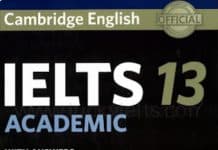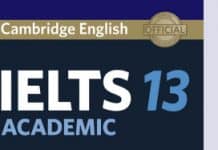If you are here, you’re probably interested in the International English Language Testing System, which might be better known as IELTS. The three passages in the IELTS Reading module deal with a wide range of academic subjects. One of the most common kinds of question in Reading is IELTS multiple choice questions.
What exactly is a multiple choice question?
Multiple choice question is a type of assessment in which you are asked to select the correct answer(s) out of the choices presented in list form by the test makers. The only correct answer is called the ‘key’, and the incorrect ones are called ‘distractors’.
As it is one of the most frequently used types of questions in the IELTS Reading test, on both the academic and general training module, you need to understand everything about it. Your task is to choose the correct remedy from the choices listed in the papers. As multiple choice questions more or less appear in one form or another, it is pivotal that you have the experience with the structure of the IELTS multiple choice questions and practice answering them before the exam.
In the following sections, we will discuss how a multiple choice question task might be presented and how to recognize different forms of answers as well as useful tips to approach this kind of task. By being able to be cognizant of distractors and irrelevant options, you will have a better chance of choosing the most appropriate one. Now, let’s get to know the IELTS multiple choice questions.
2 types of IELTS multiple choice questions
In the IELTS Reading test, there are several completely different kinds of IELTS multiple choice questions. You might be asked by the papers to choose one answer out of four possibly correct options or it could be something like that.
Of all these aforementioned, the first one is the most common.
The task might also have two completely different question forms. Either you will have to:
-
-
-
- Complete a sentence
-
-
or you will be asked to
2. Answer a question
Below are some examples of the task from an IELTS Reading academic test to get you the feel of the IELTS multiple choice questions.

In this particular case, you have to choose one answer from the mix of four possibly true choices and the task requires you to finish the sentences. Here’s an example from a reading section.

So, to put things in a nutshell, multiple choice questions take measures to check the quality along with the performance of your reading comprehension skill. It tests your proficiency in understanding the core ideas that are contained in the given text and then look for the specific information. You will also need to quickly and accurately pick out the main implication in order to identify the correct section of the text.
If you do this correctly, it will seem like the larger part of the options might be correct, and you, therefore, have to read more carefully, in much more comprehensively detail to point out the particular information that will give you the right answer.
How to deal with the IELTS multiple choice questions?
For the reading section, there are some general IELTS reading strategies that you can apply for the IELTS multiple choice questions section.
Recommend you to approach the IELTS multiple choice questions with the following steps
- Pre-reading the texts and orientate yourself to the reading and questions. You can have a sense of the general topic and the audience the passage is written for by reading the title in addition to any subheadings that stand out. However, you could try an eclectic mix of divergent approaches. Different ways work for different ones.
- Skim over the questions beforehand to have a sense of what you will be reading about, and what you will be dealing with for the next hour. The questions, realistically speaking, are generally an expeditious brief account of the main points of the passage – as they will, more often than not, ask about key points. The questions presented by the papers will help you have a general idea about the content and will give you a direction on what and where to look for information. The principal matter is to have an overall sense of the texts’ ideas and structure of the key points of the passage to help you find the answer to the questions more swiftly.
After that, follow these steps
- Read the passages. You have to read actively – underline or circle key words, write quick takeaways on the side of the papers to help you locate crucial key ideas.
- Make sure you understand the instructions correctly.
- Read the question carefully and underline keywords.
- These keywords you’ve just underlined are your target words for scanning (or spotting) in the reading passage.
- Once you find the underlined keywords from the questions in the reading passages, read carefully and thoroughly around (before and after) the keyword to find out the correct answer.
As mentioned above, there are a wide variety of essentially different methods that might work for someone but won’t for another. You should definitely adopt the strategy that you are most comfortable with. You can also adapt this general IELTS reading strategies if it suits you.
- Read the questions carefully and thoroughly.
- Skim over the passages to get the general idea of the text.
- Underline (or circle) any keywords in the questions and create a table of any synonyms that might actually appear in the reading comprehension.
- Read the choices and underline (you should not circle here because it can quickly get tricky to see all the words) any keywords. Think about the difference in meaning between these options.
- (Try to) predict the correct answer.
- Read the passage and use the keywords as well as synonyms to locate the section containing the precise answers.
- Read that part of the passage carefully, thinking about the difference in meanings.
- Think about why these answers are correct but also why the other options are wrong.
- Go back, read the questions again and mark your final answer.
Let’s do this with the aforementioned exemplars. Below, I copied the questions and spotted the keywords to look for, which are in BOLD.
Question 10: Research completed in 1982 found that in the United States soil erosion
A reduced the productivity of farmland by 20 percent.
B was almost as severe as in India and China.
C was causing significant damage to 20 percent of farmland.
D could be reduced by converting cultivated land to meadow or forest.
You could almost automatically take note of the number ‘1982’, which is usually easy to scan since it is a number and ‘the United States’, which is also easy to spot since it’s the name of a country. So I scan for 1982 and find it in the passage (1st paragraph):
“The United States, where the most careful measurements have been done, discovered in 1982 that about one-fifth of its farmland was losing topsoil at a rate likely to diminish the soil’s productivity. The country subsequently embarked upon a program to convert 11 percent of its cropped land to meadow or forest. Topsoil in India and China is vanishing much faster than in America.”
Now we read carefully in choosing the right answer. I look at the sentence with 1982 and the United States. It says that “about one-fifth of its farm was losing topsoil at a rate likely to diminish the soil’s productivity.” I observe that:
- “one-fifth” (1/5) is another way of expressing 20%. (An important part of reading comprehension the awareness of how data is expressed differently, for example, one-fourth, 1/4, a quarter and 25% are all the same.)
- “diminish” is a synonym for “reduce“, which means to make smaller or less. “Reduce” is in answer A
- productivity is a keyword for answer A
- But reading answer A carefully – it expresses that productivity will be reduced by 20%. This is a percentage about lessening productivity, but NOT ABOUT 20% of its farmland was losing topsoil “at a rate likely to diminish soil’s productivity”. This percentage refers to the measure of land.
- So we look at another answer with 20%, which would be C. Here, C expresses that soil erosion (which is another way to express “losing topsoil”) is making noteworthy damage to 20% of farmland.
- Therefore, the right answer is C.
Question 11: By the mid-1980s, farmers in Denmark
A used 50 percent less fertiliser than Dutch farmers.
B used twice as much fertiliser as they had in 1960.
C applied fertiliser much more frequently than in 1960.
D more than doubled the amount of pesticide they used in just 3 years.
Using the same method, I notice ‘mid-1980s’ and ‘Denmark’. I find the following text in the 2nd paragraph.
Fertiliser use doubled in Denmark in the period 1960-1985 and increased in The Netherlands by 150 per cent. The quantity of pesticides applied has risen too: by 69 per cent in 1975-1984 in Denmark, for example, with a rise of 115 per cent in the frequency of application in the three years from 1981.
The sentences express that fertiliser use ‘doubled’ which also means ‘twice as much’. The period mentioned was ‘1960 – 1985’, or ‘from 1960 to 1985’. This means that fertiliser used in 1985 is twice as much the amount used in 1960. Looking at the answers, we choose B.
If you still have doubts and want to check out the others – here are the reasons why I did not choose them:
A is incorrect because fertiliser use doubled (increased 100%) in Denmark and (150%) in the Netherlands (the Dutch). It only shows how much they increased their use of fertiliser within that 25-year timespan and does not discuss a direct comparison of amounts the Danes and Dutch use.
C is wrong because ‘frequency’ is not addressed for fertilizer, only for pesticides. Frequency is how often something is used, or mentioned, and is critically different from the actual amount of something being used.
D is not chosen because the frequency is, well, as mentioned above, different from the amount used.IELTS multiple choice questions
Question 12: Which one of the following increased in New Zealand after 1984?
A farm incomes
B use of fertilizers
C over-stocking
D farm diversification
After scanning for ‘New Zealand’ and ‘1984’, I find the following text in the 3rd paragraph:
In the late 1980s and early 1990s some efforts were made to reduce farm subsidies. The most dramatic example was that of New Zealand, which scrapped most farm support in 1984. A study of the environmental effects, conducted in 1993, found that the end of fertiliser subsidies had been followed by a fall in fertiliser use (a fall compounded by the decline in world commodity prices, which cut farm incomes). The removal of subsidies also stopped land-clearing and over-stocking, which in the past had been the principal causes of erosion. Farms began to diversify.
We’re looking for something that “increased”, so skimming over the above texts, we can filter out:
B (“fall in fertiliser use”)
A (“decline in world commodity prices, which cut farm incomes”)
C (“..also stopped land-clearing and over-stocking,..”)
Meanwhile, look at the last sentence, it is immediately recognizable that “farms began to diversify,” which implicates that it started, and, in other words, increased. So, the correct answer is D.
Tips on dealing with the IELTS multiple choice questions

- Read the questions before you read the passage (or the other way around, just find what you are comfortable with.)
- More often than not, you will be able to cross out up to half of the possible answers, and this leaves you with at least two options. Think about the difference in meanings between these two choices (put it in the context of the passage), this will greatly guide you to the correct answers.
- If you are unassertive of what the difference between these sentences is, you may try to rephrase them using your own command of the language.
- In case you do not have much time left, or you really do not know the answer, just make a guess. You don’t lose marks for wrong answers in the IELTS test, and you still have 25% chance of getting more points just by trusting your instincts.
- The questions’ ‘distractors’ can easily deceive you, especially keywords that look exactly like ones in the passage.
Moreover, don’t forget these tips below.
- If you know absolutely nothing about the topic of the reading test, keep calm and don’t worry. While topics of the IELTS Reading test may vary, it’s still a reading skill assessment, not a test of personal knowledge.
- Sometimes the questions are really easy that you can predict the correct answer before reading the materials. Try to do this on every question.
- Before choosing your answer, always go back and thoroughly check the questions.
- Yes, the answers will be in the same order as the structure of the text.
- You might be required to complete tasks that include both facts and opinions. They are different. Facts are stuff that is always true, or cannot be disproved but opinions is just a view or judgment formed about something. For example, “the sun is hot” is a fact, but “I love the sun” is an opinion.
Useful skills to have in the IELTS multiple choice questions section
Some general skills to have in IELTS multiple choice questions section that would give you the key to success are:
Skimming
IELTS high scorers are able to quickly get the gist of a passage by using skimming. They glance at notable titles and heading to identify the main idea.
Understanding the text’s organisation
Along with skimming, you should understand the reading passage’s organisation. How many paragraphs make up the introduction? What is the writer’s’ statement? What is the function of each paragraph? Understanding how a passage’s structure go a long way in quickly locating crucial information.
Scanning
Scanning is yet another reading skill that you might see being inundated. But how does it work? Efficient scanning requires careful study of the question. What kind of information do I need to look for? Is it a name? A year? Now scan to find them swiftly, without re-reading the whole text.
Identifying paraphrase
Almost all IELTS reading multiple choice questions are paraphrased from the original word choices. Yes, it helps to have a considerable amount of vocabulary, but size is, as always, not everything. Conceptual words like ‘avoid/discover’ are usually paraphrased, while technical naming like ‘infectious disease’ or ‘silicon chip’ are more likely to be in the text, probably due to the fact that it’s admittedly quite hard to paraphrase these kinds of word.
Guessing unknown words
It is almost guaranteed that you will find words that you’ve never seen before in the IELTS Academic Reading module. The writers place them here to verify if candidates are able to figure them out using contextual clues. Good reading score requires more than just a dictionary; you should have the skills to analyse unknown words and guess its most likely meaning.
To learn new words, why don’t you try the free eJOY extension? This amazingly reliable tool can help you learn new vocabulary swiftly and effortlessly. You can save them to review later when you practice reading English. Isn’t that convenient?
Download eJOY free here
Time management
Every question in the Reading module gives the same amount of points, so try your best to answer the 30 easiest questions, and give the remaining 10 your best guess. If you’re still unsure of an answer, give it a guess, move on to the next question, and come back later (if there’s still time).
Common mistakes you might make while doing the IELTS multiple choice questions
Not answering the questions
This one might seem obvious, but it would shock you how many people don’t seem to answer the question at all.
Not understand examiners’ tricks
The test givers love to deceived with ‘distractors’. A very common trick is matching keywords from the options to parts of the passage. Just because there are a lot of matching keywords doesn’t mean it’s the correct answer.
Not reading the whole sentence
The first part of a sentence might look correct but the other parts might change everything. Linking words such as “but” or “however” can modify the meaning of a whole sentence. Examiners know you are trying to answer everything as quickly as possible, so they might try to trick you in this way.
Important notes
- Answers come in order
- Look out for the title, headings, and any special features.
- Pay attention to timing, do not spend too much time on a question or passage
- Check your answers
- And write your answers on the answer sheet.
Example of the IELTS multiple choice questions and answers

1. The book Educating Psyche is mainly concerned with
A. the power of suggestion in learning
B. a particular technique for learning based on emotions.
C. the effects of emotion on the imagination and the unconscious.
D. ways of learning which are not traditional.
2. Lozanov theory claims that then we try to remember things,
A. unimportant details are the easiest to recall.
B. concentrating hard produces the best results.
C. the most significant facts are most easily recalled.
D. peripheral vision is not important.
3. In this passage, the author uses the examples of a book and a lecture to illustrate that
A. both these are important for developing concentration.
B. his theory about methods of learning is valid.
C. reading is a better technique for learning than listening.
D. we can remember things more easily under hypnosis.
4. Lozanov claims that teachers should train students to
A. memorise details of the curriculum.
B. develop their own sets of indirect instructions.
C. think about something other than the curriculum content.
D. avoid overloading the capacity of the brain.














![[IELTS Reading] Matching Information – No.1 Matching information question type in IELTS Reading](/wp-content/uploads/2018/08/IE-Reading-Matching-information-100x70.png)
![Adverbs Describing Degree of Change [IELTS Writing Task 1/Vocabulary] Adverbs Describing Degree of Change in IELTS Writing Task 1](/wp-content/uploads/2018/08/1_0wZc53qZye1hU6IGar8GjQ-100x70.jpeg)